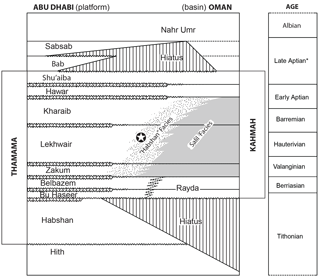the Creative Commons Attribution 4.0 License.
the Creative Commons Attribution 4.0 License.
Cylindroporella sugdeni Elliott, 1957, an Early Cretaceous Middle Eastern Dasycladalean alga – a revision
Bruno R. C. Granier
The type material of Cylindroporella sugdeni Elliott, 1957, is revised. The total lack of sterile laterals and consequently the absence of the diagnostic feature of the genus Cylindroporella, i.e., the alternation of sterile and fertile laterals within the same whorl, leads to its exclusion from the genus Cylindroporella Johnson, 1954, and to its ascription to the genus Holosporella Pia, 1930. Recent stratigraphic investigations suggest that the stratum typicum originally reported as Early Cretaceous in age is more precisely Hauterivian or possibly Early Barremian in age.
- Article
(5899 KB) - Full-text XML
- BibTeX
- EndNote
Except for the fossil species ascribed to the fossil family Seletonellaceae in which the lateral expansions are randomly distributed along the alga main axis, the Dasycladalean algae have laterals arranged in regular rows that are called “verticils”. The latter comprise either sterile laterals or fertile laterals, except for the representatives of Cylindroporella Johnson, 1954, and Korkyrella Sokač & Velić ex Sokač, 2004, both ascribed to the fossil family Triploporellaceae. Having their sterile and fertile laterals occurring in alternation within the same row, both genera have a unique body plan amidst the fossil and living Dasycladalean algae. The more their representatives are reassessed, the more one questions the existence of such a body plan (see Barattolo and Parente, 2000, for instance).
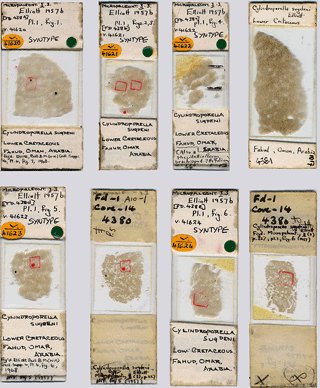
Figure 1The set of six thin sections studied. Both sides of 41623 and 41624 are visible; the back sides of them were rotated in order to make the text readable.
Following the description of its type species, Cylindroporella barnesii Johnson, 1954, two new species were introduced by Elliott (1957): the Early Cretaceous C. sugdeni and the Late Jurassic C. arabica. The revision of the second species listed, i.e., C. sugdeni Elliott, 1957, is addressed below.
Thanks to a loan organized by the Department of Palaeobotany of the Natural History Museum, London, the five thin sections that correspond to the type material of Cylindroporella sugdeni Elliott, 1957, which are currently stored in the Collection PAL (Palaeontology) under numbers PB V 41620 to 41624 (Fig. 1), were examined. The thin section labels indicate that the material comes from a depth of 4380', i.e., 1335 m (measured depth, MD), from core 14 in well Fahud 1 in Oman.
In addition to this material, another thin section, which is part of a set given by Graham F. Elliott to Jacques Emberger (Université de Bordeaux), was also studied. The label of this thin section implies it comes from the well “Fahud 1 (Oman), core 14, depth 4381' (MD)”. This last thin section is currently deposited with a LPB (Laboratoire de Paléontologie de Brest) number in the collections of the Département des Sciences de la Terre et de l'Univers, Université de Bretagne Occidentale, Brest (France).
The dominant texture is a bioclastic grainstone with micritized grains of all sizes (peloids to aggregates, micritic extraclasts) and a few ooids. The skeletal grains consist mostly of the new alga, indeterminate lituolid and textulariid foraminifers, rare Praechrysalidina infracretacea Luperto Sinni, 1979, and echinoderm remains. Unfortunately, the thin sections are rather thick (probably thicker than 30 µm). The original piece of limestone was porous but it was not injected with resin in order to consolidate it. As a consequence the material is locally crumbled (with local overlaps) or was partly removed. In addition, small air bubbles are trapped in the Canada balsam. In order to better understand the alga structure, a photo editor was used to color in blue the holes in the thin section views (Fig. 2); then some visible features (Fig. 3), possibly belonging to the alga, were contoured.
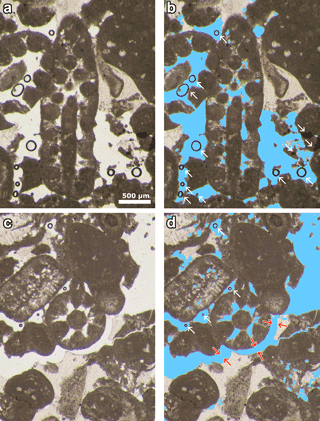
Figure 2(a–b) Oblique section, paratype (one of the syntypes), thin section PB V 41624 (Elliott, 1957, pl. 1, fig. 6); (c–d) transverse section, paratype (one of the syntypes), thin section PB V 41623 (Elliott, 1957, pl. 1, fig. 3). The parts colored in blue correspond to parts removed while making the thin section and possibly some original porosity. White arrows pointing to the upper right indicate air bubbles and those pointing to the lower left indicate overlaps in the thin section manufacturing; opposing red arrows indicate an induced fracture. All photos on the same scale (scale bar = 500 µm).
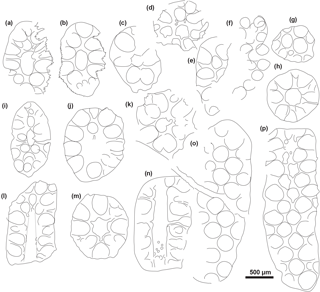
Figure 3Contours of some algal remains. (a–b, g-h, j, l) Thin section PB V 41621; (c, f, i, m) thin section PB V 41622; (d–e, k, n–p) thin section PB V 41620. (d) Syntype (Elliott, 1957, pl. 1, fig. 1); (h) syntype (Elliott, 1957, pl. 1, fig. 3); (l) syntype (Elliott, 1957, pl. 1, fig. 2); (m) syntype (Elliott, 1957, pl. 1, fig. 4). All drawings on the same scale (scale bar = 500 µm).
3.1 Type locality
Well Fahud 1 (coordinates: 22∘17′25.4 N, 56∘30′52.6 E) was “spudded-in” on 18 January 1956. According to Morton (2006, p. 191), “Drilling was completed at a depth of 3760 m in the Paleozoic evaporites, probably Cambrian, on 28 May 1957”. From ca. 850 to ca. 1650 m depth, it drilled through the Lower Cretaceous Kahmah Group of Oman (Fig. 4).
3.2 Stratigraphical background
The name of the Lower Cretaceous group changes across the international boundary. In the United Arab Emirates (UAE, among which is the emirate of Abu Dhabi) and in Saudi Arabia, the equivalent Lower Cretaceous unit is called the Thamama Group (Fig. 4). Core 14 with Cylindroporella sugdeni Elliott, 1957, was retrieved from an interval labeled as “Habshan”. For decades, oil and gas company geologists have developed and used an interregional stratigraphic framework for this interval (e.g., Hassan et al., 1975). According to Granier (2000; Granier et al., 2003), most of their operational units prove to be unconformity-bounded units. In addition, because they can also be characterized by their discrete fossil contents, Granier (2008) treats them as genuine regional stages. In Abu Dhabi, the shallow-water carbonate units of the Thamama Group comprise, from top to bottom, the Bab and the Shu'aiba (Upper Aptian), the Hawar (Lower Aptian), the Kharaib (Upper Barremian–Lower Aptian), the Lekhwair (Upper Valanginian–Hauterivian–Lower Barremian), the Zakum (Lower Valanginian), the Belbazem (Berriasian), the Bu Haseer (transition of the Tithonian to the Berriasian), and the Habshan (Tithonian). However, in Oman, the shallow-water carbonates of the lower part of the interval may be missing or they may pass to hemipelagic and pelagic facies of the Kahmah Group (Granier, 2000, 2008; Granier et al., 2003). In addition to the UAE units, two facies-driven formations were originally described from the Kahmah Group in Oman: the Rayda and the Salil (e.g., see Hassan et al., 1975). The Rayda, which is also an unconformity-bounded unit, is time equivalent to both the Bu Haseer and Belbazem (Tithonian–Berriasian). The Salil facies is the basinal time equivalent to the rest of the stratigraphic column (Valanginian–Aptian pars). Accordingly, there are not only geopolitical reasons but also geological reasons (ages, hiatuses, and development of basinal facies) that may justify the use of the Thamama Group in the UAE and that of the Kahmah Group in Oman.
3.3 Stratigraphic location of the type level
In well Fahud 1, the lithostratigraphic succession identified by Petroleum Development Oman (PDO) and Shell geologists comprises, from top to bottom, the “Shu'aiba” (that includes the Hawar), the Kharaib, the “Lekhwair”, the “Habshan”, and the Salil (Fig. 4). The use of quotation marks is justified by the fact that the definition of these units does not match the regional standardized scheme (Hassan et al., 1975; Granier 2000, 2008; Granier et al., 2003). This is especially true in the case of the Habshan of the well Fahud 1, which refers to a transitional zone between the Salil basinal facies below and Lekhwair facies above and which has no connection with the type Habshan in Abu Dhabi (latest Jurassic in age). In conclusion, because the type level of Cylindroporella sugdeni Elliott, 1957, is located in the median part of an interval equivalent to the type Lekhwair (it is not located in the Kharaib as erroneously stated in Granier, 2008), and although an Early Barremian age cannot be excluded, it is most probably Hauterivian in age (Fig. 4).
4.1 Comparison with other species
As stated in the introduction above, there are only two genera the sterile and fertile laterals of which occur in alternation within the same row: Korkyrella Sokač & Velić ex Sokač, 2004 and Cylindroporella Johnson, 1954.
Korkyrella Sokač & Velić ex Sokač, 2004, which is monospecific, is based on K. texana Johnson ex Sokač, 2004 (“Salpingoporella texana Johnson, 1965”, nom. nud.). On the one hand, Cylindroporella is also a valid name for a Bryozoan genus, Cylindroporella Hincks, 1877, based on Lepralia tubulosa Norman, 1868, which is its sole representative. On the other hand, some years ago there were still nearly 20 species referring to the algal genus Cylindroporella Johnson, 1954, which is based on Cylindroporella barnesii Johnson, 1954. Today, due to some recent revisions, the number of its representatives has significantly diminished (Table 1).
Table 1Nomenclatural changes that have affected more than half of the former representatives of the genus Cylindroporella Johnson, 1954.
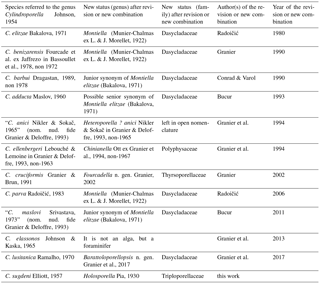
According to Sokač (2004), sterile laterals of Korkyrella texana Johnson ex Sokač, 2004, are rather long and thin primaries; the fertile laterals consist of ovoid primaries followed by short secondaries. According to Conrad (1982), sterile laterals of Cylindroporella barnesii Johnson, 1954 consist of rather long and thin primaries followed by short secondaries; the fertile laterals are ovoid primaries. However, Cylindroporella sugdeni Elliott, 1957 does not match any of these diagnostic criteria. There are not any long and thin laterals, supposedly sterile, but only ovoid primaries without secondaries, supposedly fertile. In tangential sections, the empty spaces remaining between adjacent ovoid primaries could have been confused with sterile primaries. In this case, the algal sections may recall those of Montiella elitzae (Bakalova, 1971), a form with laterals consisting of a thin primary bearing a thin secondary and an ovoid ampulla at its outer end. Nonetheless, several photomicrographs clearly attest the lack of fertiles. Consequently, the species is transferred to the genus Holosporella (Pia, 1930), which is characterized by a simple body plan with a main axis bearing closely set verticils of vesicular laterals, commonly arranged in a quincunx from one verticil to the next.
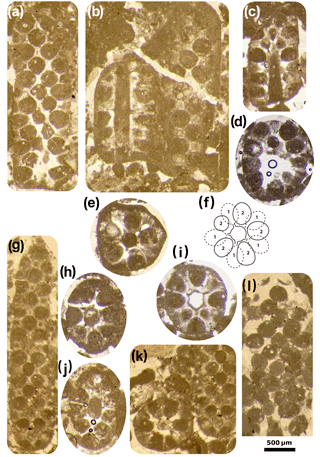
Figure 5(a) Tangential section, paratype (one of the syntypes), thin section PB V 41620 (Fig. 3p; Elliott, 1957, pl. 1, fig. 1); (b) axial (left) and tangential (right) sections, thin section PB V 41620 (Fig. 3n–o); (c) oblique section, lectotype (one of the syntypes), thin section PB V 41621 (Fig. 3l; Elliott, 1957, pl. 1, fig. 2); (d) oblique section, thin section PB V 41621 (Fig. 3j); (e) transverse section, paratype (one of the syntypes), thin section PB V 41623 (Elliott, 1957, pl. 1, fig. 5); (f) sketch of photomicrograph 5e illustrating the imbrication of two whorls. The solid lines correspond to the laterals of one whorl (2) and the main axis with the peduncular parts of the laterals of the next whorl. The dotted lines correspond to the laterals of the next whorl (1); (g) tangential section, thin section 4381, Collection Emberger, Brest; (h) sub-transverse, slightly oblique section, thin section PB V 41624; (i) sub-transverse, slightly oblique section, paratype (one of the syntypes), thin section PB V 41622 (Fig. 3m; Elliott, 1957, pl. 1, fig. 4); (j) slightly oblique section, thin section PB V 41621; (k) axial (left) and tangential (right) sections, thin section 4381, Collection Emberger, Brest; (l) subtangential, slightly oblique section (the main axis is visible at the bottom of the picture), Collection Emberger, Brest. All photos on the same scale (scale bar = 500 µm).
Phylum Chlorophyta
Class Dasycladophyceae Hoek et al.
Order Dasycladales Pascher
Family Triploporellaceae Pia, 1920
Tribe Salpingoporelleae Bassoullet et al., 1979
Genus Holosporella Pia, 1930
Holosporella sugdeni Elliott, 1957, nov. comb.
(Figs. 2–3 and 5)
1957 Cylindroporella sugdeni Elliott: 227, pl. 1, figs. 1–6.
1968 Cylindroporella barnesii Johnson; Elliott: 37, pl. 6, fig. 3.
1968 Cylindroporella sugdeni Elliott; Elliott: 38, pl. 6, figs. 5 (Elliott, 1957, pl. 1, fig. 2), 6 (Elliott 1957, pl. 1, fig. 5), and 7 (Elliott, 1957, pl. 1, fig. 1).
1968 Cylindroporella sugdeni Elliott; Johnson: 36, pl. 6, fig. 4.
1969 Cylindroporella sugdeni Elliott; Johnson: 56, 153, pl. 41, figs. 1 (Elliott, 1957, pl. 1, fig. 1), 2 (Elliott, 1957, pl. 1, fig. 5), 3 (Elliott, 1957, pl. 1, fig. 2), 4 (Elliott, 1957, pl. 1, fig. 4), and 5 (Elliott, 1957, pl. 1, fig. 6).
non 1971 Cylindroporella sugdeni Elliott; Basson & Edgell: 417, pl. 2, figs. 1–3 (Montiella elitzae; Bakalova, 1971).
1971 Cylindroporella sugdeni Elliott; Basson & Edgell: 417, pl. 2, fig. 4.
1978 Cylindroporella sugdeni Elliott; Bassoullet et al.: 179–181, pl. 8, figs. 1 (Elliott, 1957, pl. 1, fig. 1), 2 (Elliott, 1957, pl. 1, fig. 2), and 3.
Original diagnosis: (Elliott, 1957) “Large, thick
cylindroporelliform segments, agreeing in internal structure with those of
Cylindroporella barnesii, but with greater diameter of central canal
and sporangia and externally, and a greater distance between whorls; it is
proportionally shorter and much thicker than the type species (…)”.
Description: Thalli
are found in the form of broken calcareous tubes with an axial cavity in lieu
of the main axis and globular pores in lieu of the laterals. The inner
diameter of such a calcareous coating commonly represents one-fourth of its
outer diameter. The calcification may vary from one specimen to the others or
within a single specimen. Usually it forms a thin crust around the laterals
and the main axis. Micritic infills may be observed above and beyond this
crust (Fig. 5b right, g and k right) but in some cases the “intercellular”
space, i.e., the empty space remaining between the vesicular laterals and the
main axis, is filled in by a drusy calcite cement (Fig. 5a and l).
Previously, such intercellular micritic infills with ill-defined contours
were erroneously interpreted as thin sterile laterals.
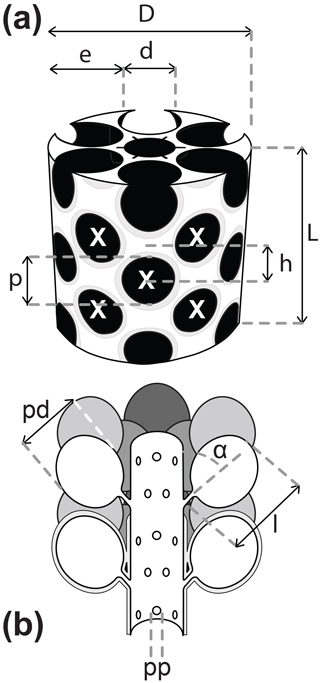
Figure 6Reconstructions (a) of a heavily calcified Holosporella and (b) of a weakly calcified one. In (a) the five X's at the center of the pores illustrate the quincunx arrangement of the laterals. Key for the measurements is as follows. L: maximum length observed; D: outer diameter; d: inner diameter; h: whorl spacing; e: thickness of the calcareous coating; α: angle of the pore to the main axis; l: length of the primary pores; p: visible width of a primary pore; pp: width of the proximal part of the primary pores; pd: maximum width of the primary pores.
No unquestionably cyst-like structures were observed but the laterals are supposedly fertile because their volume is significantly larger than that of the axis cavity, which excludes that the species is endosporous (with cysts located in the main axis) and supports it being interpreted as cladosporate (with cysts located in the primary laterals). The proximal part of these laterals consists of a short and narrow peduncle (Fig. 5c, h–j and k left) that expands abruptly into the characteristic wider vesicular part.
Ovoid laterals from successive verticils have a quincunx arrangement
(Fig. 6a) that results from the imbrication of the verticils, clearly visible
in tangential sections (Fig. 5a, b right, g, k right and l). The imbrication
ratio is computed by the difference between the maximum width of a lateral,
i.e., the thickness of a verticil, and the distance between two successive
verticils at their insertion points, divided by this last distance.
Imbrication is particularly strong in this species in which it represents
nearly two-thirds of the whorl spacing.
Emended diagnosis:
Rather large Holosporella species with a relatively narrow main axis
and strongly imbricated verticils of wide vesicular laterals, supposedly
fertile. Using the various measurements listed below (D, d, d∕D, h,
etc.) may help discriminate it from the other representatives of the genus.
Lectotype: The lectotype (Figs. 3l
and 5c) selected here is the oblique section of pl. 1, fig. 2 of
Elliott (1957) from the thin section labeled PB V 41621.
Remark: Some features
observed in axial sections are not visible in transverse sections and vice
versa. Oblique sections should always be preferred as a type (holotype,
lectotype, neotype) to axial and transverse sections because a
palaeophycologist usually gathers more information from oblique sections than
from any axial or transverse section.
Paratypes: The
paratypes are the five remaining specimens: pl. 1, fig. 1 of Elliott (1957)
from the thin section labeled PB V 41620 (Fig. 5a); pl. 1, fig. 3 of
Elliott (1957) from the thin section labeled PB V 41621 (Figs. 2c–d and 3h);
pl. 1, fig. 4 of Elliott (1957) from the thin section labeled PB V 41622
(Figs. 3m and 5i); pl. 1, fig. 5 of Elliott (1957) from the thin section
labeled PB V 41623 (Fig. 5e–f); and pl. 1, fig. 6 of Elliott (1957) from the
thin section labeled PB V 41624 (Fig. 2a–b).
Measurements: (Fig. 6)
-
L (maximum length observed) = 5.8 mm versus > 3.0 mm for Elliott (1957);
-
D (outer diameter) = 1.07 ± 0.12 mm (18 measurements), minimum = 0.84 mm, maximum = 1.26 mm versus 0.78–1.14 mm for Elliott (1957);
-
d (inner diameter) = 0.27 ± 0.05 mm (18), minimum = 0.18 mm, maximum = 0.35 mm versus 0.23–0.36 mm for Elliott (1957);
-
d∕D = 25.0 ± 3.7 % (18)
-
h (whorl spacing) = 0.20 mm in average (seven measurements) versus 0.39 mm for Elliott (1957) who erroneously did not measure the distance of two successive whorls, but instead the distance of two whorls with an intermediate one;
-
e (thickness of the calcareous coating) = D−2d = 0.53 ± 0.10 mm (18);
-
α (angle of the pore to the main axis) = ca. 60∘;
-
l (length of the primary pores) = e∕sin α = ca. 0.56 mm;
-
pp (width of the proximal part of the primary pores) = 0.04 mm;
-
pd (maximum width of the primary pores) = 0.33 mm versus 0.31 mm for Elliott (1957);
-
i (imbrication of the whorls) = pd − h=0.13 mm, a positive value;
-
i∕h (imbrication ratio) = (pd − h)∕h = ca. 65 %;
-
w (number of pores per verticil) = 5 to 8.
Holosporella sugdeni Elliott, 1957, nov. comb., is known with certainty at least from the Lekhwair and Kharaib of Abu Dhabi (Granier et al., 2003) and from the Jezzinian of Lebanon (Basson and Edgell, 1971), i.e., from the Hauterivian and Barremian interval in the Middle East. More than half a century after it was introduced by Elliott (1957), there are few correct identifications of this species. Records outside this region commonly come with “cf.” or “aff.” and do not expressly refer to this species but most probably to Montiella elitzae (Bakalova, 1971). Thus, Holosporella sugdeni Elliott, 1957, nov. comb., might be an endemic species.
Following the revision of this species, the genus Cylindroporella Johnson, 1954, has lost another representative. As Barattolo and Parente (2000) did earlier, one can question the existence of its unique body plan with sterile and fertile laterals occurring in alternation within the same row. Further investigations on this fossil algal genus are requested, requiring the revision of its remaining representatives and its type species.
No data sets were used in this article.
The author declares that he has no conflict of interest.
I wish to thank Petroleum Development Oman (PDO) and Shell, and particularly
Michael Darke, Gordon Forbes and Iain Prince for having shared some
proprietary information on well Fahud 1 with me; I wish to acknowledge the
help of Michael Quentin Morton, who acted as a facilitator. I am also
indebted to the Natural History Museum, London, and specifically to
Lee S. Davies and Lil Stevens for having organized the loan of Elliott's
original material. I am grateful to Filippo Barattolo and Geraint Wyn Hughes
for having reviewed the paper and suggesting helpful improvements. Last but
not least, special thanks are due to Phil Savador for having polished the
English text of a previous version of this paper.
Edited by: Francesca Sangiorgi
Reviewed by:
Filippo Barattolo and Geraint Wyn Hughes
Bakalova, D.: Nouvelles espèces de Dasycladaceae (Algae) dans les sédiments urgoniens du Prébalkan central, Bulletin of the Geological Institute, Bulgarian Academy of Sciences – Committee of Geology (Series Paleontology), XX, 123–127, 1971.
Barattolo, F. and Parente, B.: New observations on Uragiella liasica (Lebouché & Lemoine) (green algae, Dasycladales) from the type-locality (Canders, Languedoc – Southern France), Bollettino della Società Paleontologica Italiana, 39, 123–137, 2000.
Basson, P. W. and Edgell, H. S.: Calcareous algae from the Jurassic and Cretaceous of Lebanon, Micropaleontology, 17, 411–433, 1971.
Bassoullet, J.-P., Bernier, P., Conrad, M. A., Deloffre, R., and Jaffrezo, M.: Les algues Dasycladales du Jurassique et du Cretacé, Géobios, Mémoire spécial, 2, 1–330, 1978.
Bassoullet, J.-P., Bernier, P., Deloffre, R., Génot, P., Jaffrezo, M., and Vachard, D.: Essai de classification des Dasycladales en tribus, Bulletin des Centres de Recherches Exploration-Production elf-Aquitaine, 3, 429–442, 1979.
Bucur, I. I.: Some new or poorly known calcareous algae (Dasycladales, Gymnoco-diaceae) in the Lower Cretaceous deposits from the Resita-Moldava Noua Zone (Southern Carpathians, Romania), Revista Española de Micropaleontologia, 25, 93–126, 1993.
Bucur, I. I.: Early Barremian dasycladalean algae from Serre de Bleyton (Drôme, SE France), Annalen des Naturhistorischen Museums in Wien, Serie A, 113, 619–653, 2011.
Conrad, M. A.: Comments on Korkyrella and other Dasycladaceae, Revue de Paleobiologie, 1, 1–3, 1982.
Conrad, M. A. and Varol, B.: Cylindroporella taurica, n. sp., urges to review different patterns of calcification in the Mesozoic Dasycladales (green algae), Arch. Sci., 43, 193–214, 1990.
Dragastan, O.: Microfaciés de la série calcaire, crétacée inférieure d'Aliman (Dobrogea de Sud), Dari de Seama ale Sedintelor, LXIV, 107–136, 1978.
Dragastan, O.: Calcareous algae (new and revised), Microproblematicae and Foraminiferida of Jurassic-Lower Cretaceous deposits from the Carpathians area, Revista Española de Micropaleontologia, XXI, 5–65, 1989.
Elliott, G. F.: New calcareous algae from the Arabian Peninsula, Micropaleontology, 3, 227–230, 1957.
Elliott, G. F.: Permian to Palaeocene calcareous algae (Dasycladaceae) of the Middle East, Bulletin of the British Museum (Natural History) Geology, Supp., 4, 3–111, 1968.
Fourcade, E., Jerez, L., Rodríguez Estrella, T., and Jaffrezo, M.: El Jurásico terminal y el Cretácico Inferior de la Sierra de la Muela (Provincia de Murcia), Consideraciones sobre las biozonas con Foraminíferos del Albense-Aptense del SE de España, Revista Española de Micropaleontología, no. extraord. XXX Aniv., 215–248, 1972.
Granier, B.: Révision de Cylindroporella benizarensis Fourcade et alii ex Jaffrezo in Bassoullet et alii 1978, Revista española de Micropaleontologia, XXXII, 305–311, 1990.
Granier, B.: Lower Cretaceous stratigraphy of Abu Dhabi and the United Arab Emirates- A reappraisal, in: The 9th Abu Dhabi International Petroleum Exhibition & Conference, Conference Proceedings, ADIPEC 0918, 526–535, 2000.
Granier, B.: Algues Dasycladales, nouvelles ou peu connues, du Jurassique supérieur et du Crétacé inférieur du Moyen-Orient, in: Research advances in calcareous algae and microbial carbonates, edited by: Bucur, I. I. and Filipescu, S., Proceedings of the 4th IFAA Regional Meeting, 103–113, Cluj-Napoca, 2002.
Granier, B.: Holostratigraphy of the Kahmah regional Series in Oman, Qatar, and the United Arab Emirates, Carnets Geol., CG2008_A07, 1–33, 2008.
Granier, B. and Brun, R.: Cylindroporella cruciformis et Holosporella arabica, deux Dasycladacées nouvelles du Groupe Thamama, (? Portlandien-) Berriasien- Aptien d'Abu Dhabi, Émirats Arabes Unis., Cretaceous Res., 12, 403–410, 1991.
Granier, B. and Busnardo, R.: New stratigraphic data on the Aptian of the Persian Gulf, in: Spatial patterns of change in Aptian carbonate platforms and related events, edited by: Skelton, P., Granier, B., and Moullade, M., Cretaceous Res., 39, 170–182, 2013.
Granier, B. and Deloffre, R.: Inventaire des Algues Dasycladales fossiles. II∘ partie – Les Algues Dasycladales du Jurassique et du Crétacé, Revue de Paléobiologie, 12, 19–65, 1993.
Granier, B., Masse, J.-P., and Berthou, P.-Y.: Heteroporella lepina Praturlon, 1967, revisited (followed by taxonomic notes on the so-called “Heteroporella” species), Beiträge zur Paläontologie, 19, 129–141, 1994.
Granier, B., Al Suwaidi, A. S., Busnardo, R., Aziz, S. K., and Schroeder, R.: New insight on the stratigraphy of the “Upper Thamama” in offshore Abu Dhabi (U.A.E.), Carnets Geol., CG2003_A05_BG_et al., 1–17, 2003.
Granier, B., Radoičić, R., and Drobne, K.: Revision of the Jesse Harlan Johnson Collection. Part 1. Some fossil Dasycladales from Guatemala, Carnets Geol., CG2013_A07, 58, 66, 82, 88, 104, 130, 208 & 280–301, 2013.
Granier, B., Azerêdo, A. C., and Ramalho, M. M.: Taxonomic revision of Cylindroporella ? lusitanica Ramalho, 1970: In search for the origins of the Family Dasycladaceae, Isl. Arc, 26, e12176, https://doi.org/10.1111/iar.12176, 2017.
Hassan, T. H., Mudd, G. C., and Twombley, B. N.: The stratigraphy and sedimentation of the Thamama Group (Lower Cretaceous) of Abu Dhabi, in: Ninth Arab Petroleum Congress, Dubai, 107, 1–11, 1975.
Hincks, T.: LXVI. On British Polyzoa – Part II. Classification, Annals and Magazine of Natural History, XX, 520–532, 1877.
Johnson, J. H.: Cretaceous Dasycladacea from Gillespie county, Texas, J. Paleontol., 25, 787–790, 1954.
Johnson, J. H.: Three Lower Cretaceous algae new to the Americas, J. Paleontol., 39, 719–720, 1965.
Johnson, J. H.: Lower Cretaceous algae from the Blake Escarpment, Atlantic Ocean and from Israel, Professional Contributions of the Colorado School of Mines, 5, 1–46, 1968.
Johnson, J. H.: A review of the Lower Cretaceous Algae, Professional Contributions of the Colorado School of Mines, 6, 1–180, 1969.
Johnson, J. H. and Kaska, H. V.: Fossil Algae from Guatemala, Professional Contributions of the Colorado School of Mines, 1, 1–152, 1965.
Lebouché, M. C. and Lemoine, M.: Dasycladacées nouvelles du Lias calcaire (Lotharingien) du Languedoc méditerranéen, Revue de Micropaléontologie, 6, 89–101, 1963.
Luperto Sinni, E.: Praechrysalidina infracretacea n. gen. n. sp. (Foraminiferida), Studi geologici e morfologici sulla Regione Pugliese, 5, 1–16, 1979.
Maslov, V. P.: Novoye Vodorosli Mela Kopet-Daga (Turkmeniya) [New Cretaceous algae of Kopet Dag (Turkmenia)], Doklady Akademii Nauk SSSR, 134, 939–941, 1960 (in Russian).
Morellet, L. and Morellet, J.: Nouvelle contribution à l'étude des Dasycladacées tertiaires, Mem. S. Geo. F., XXV, 1–35, 1922.
Morton, M. Q.: In the heart of the desert, Green Mountain Press, Aylesford, 2006.
Nikler, L. and Sokač, B.: Cylindroporella anici n. sp., New Dasycladacea from the Malm of Velebit, Bulletin scientifique, Conseil des Académies des Sciences et des Arts de la R.S.F. de Yougoslavie, Section A: Sciences naturelles, techniques et médicales, 10, 106–107, 1965.
Norman, A. M.: Notes on some rare British Polyzoa, with descriptions of new species, Q. J. Microsc. Sci., 8, 212–222, 1868.
Ott, E.: Dasycladaceen (Kalkalgen) aus der nordalpinen Obertrias, Mitteilungen der Bayerischen Staatssammlung für Paläontologie und historische Geologie, 7, 205–226, 1967.
Pia, J.: Die Siphoneae verticillatae vom Karbon bis zur Kreide, Abhandlungen der zoologisch-botanischen Gesellschaft in Wien, XI, 1–259, 1920.
Pia, J.: Upper Triassic fossils from the Burmo-Siamese frontier, A new Dasycladacea, Holosporella siamensis nov. gen., nov. sp., with a description of the allied genus Aciculella Pia, Records of the Geological Survey of India, LXIII, 177–181, 1930.
Radoičić, R.: Contribution to the reconsideration of a group of cylindroporelliform dasyclads, Bulletin de l'Académie Serbe des Sciences et des Arts, LXXII, 109–115, 1980.
Radoičić, R.: Dazikladacee Cylindroporella parva n. sp. iz gornje krede Libije i Clypeina pastriki n. sp. iz gornje krede Dinarida i Libije, Bulletin de l'Académie Serbe des Sciences et des Arts, CCCXXXV, 65–80, 1983 (in Serbian).
Radoičić, R.: Trinocladus divnae and Montiella filipovici – a new species (Dasycladales, green algae) from the Upper Cretaceous of the Mountain Paštrik (Mirdita Zone), Annales géologiques de la Péninsule balkanique, 67, 65–87, 2006.
Ramalho, M. M.: Cylindroporella lusitanica, une nouvelle Dasycladacée du Jurassique supérieur portugais, Boletim da Sociedade Geológica de Portugal, 17, 123–127, 1970.
Sokač, B.: On some peri-Mediterranean Lower Cretaceous Dasyclad species (calcareous algae; Dasycladales) previously assigned to different genera, Geol. Croat., 57, 15–53, 2004.
Srivastava, N. K.: Neocomian calcareous algae from Bolshoi Balkhan, USSR, Neues Jahrb. Geol. P. M., 11, 690–708, 1973.






